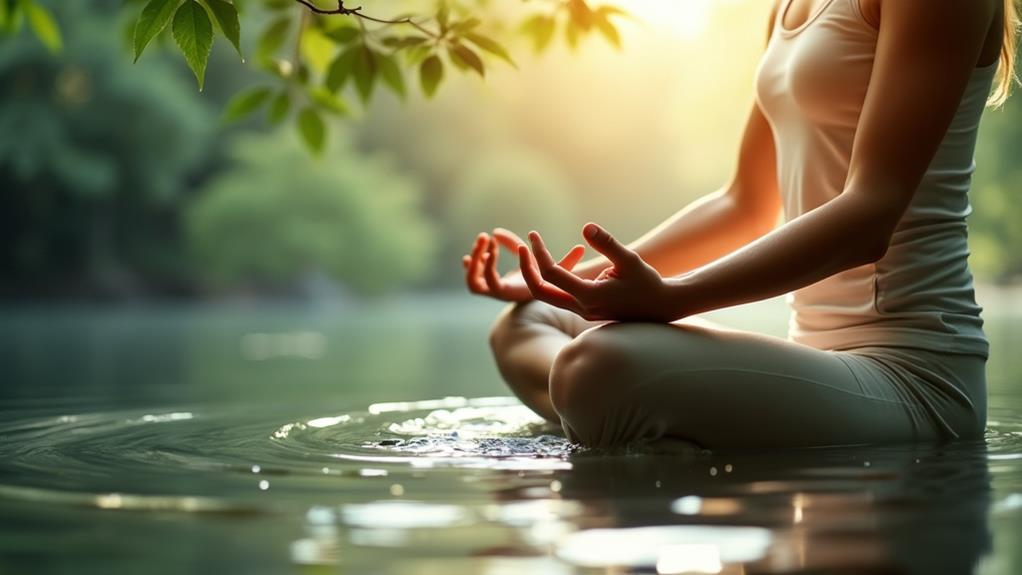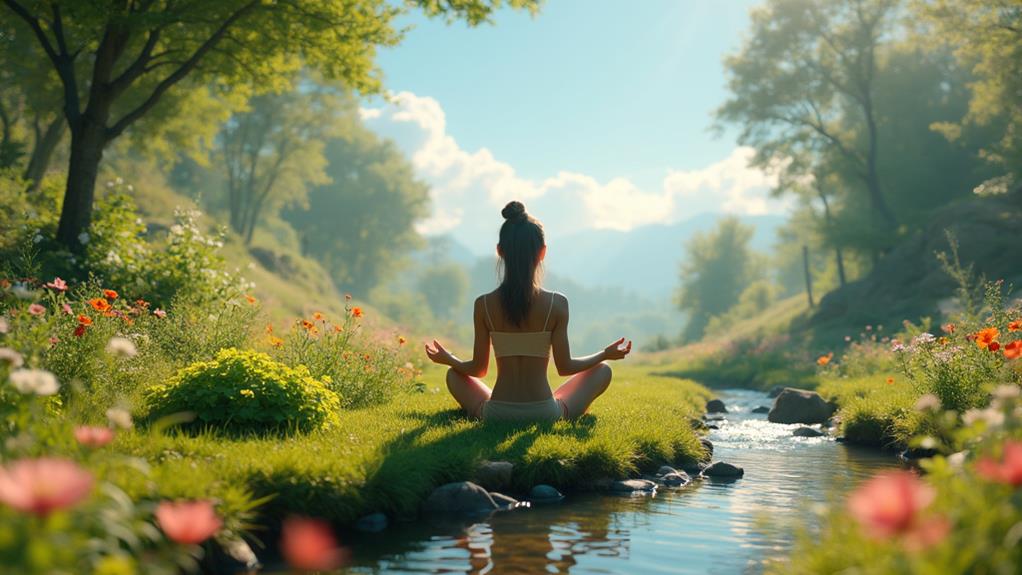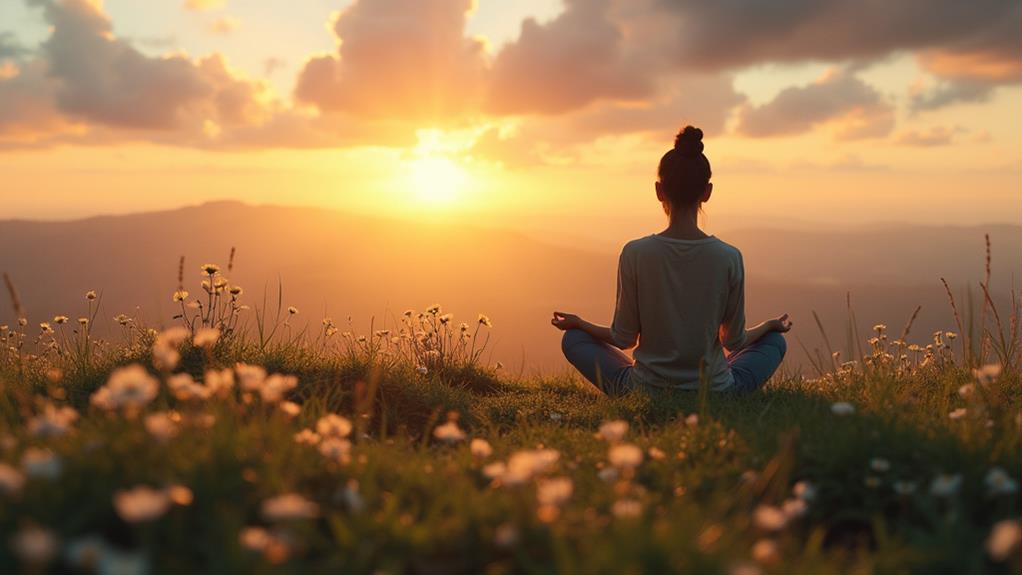Imagine standing in a quiet forest, the rustle of leaves calming your racing thoughts. You might not have the luxury of nature every day, but you can still cultivate a sense of peace amidst the chaos of daily life. Mindfulness techniques, like focused breathing and body scans, offer practical ways to ground yourself and reduce stress. The beauty of these methods lies in their simplicity and accessibility; you just have to know where to start. Curious about how a few small shifts can transform your experience of stress?
Focused Breathing

Focused breathing is a powerful tool that can anchor you in the present moment, easing the weight of stress. By developing breath awareness, you create a sanctuary amid life's chaos.
Start with diaphragmatic breathing—placing your hand on your belly, feel it rise with each intentional inhalation. This simple act encourages deeper breaths and invites calmness.
You might find breath counting helpful. As you inhale, count to four, hold for a moment, then exhale slowly to six. This rhythmic breathing not only focuses your mind but also promotes relaxation.
Incorporating mindful pauses throughout your day can keep you grounded, allowing you to reset whenever stress creeps in.
Visualize your breath as a wave, flowing in and out, washing away tension. With each exhale, imagine releasing negativity and inviting peace. As you practice, you'll notice that exhale relaxation becomes a natural response to stress.
Don't hesitate to return to these techniques whenever you need a break. By consistently practicing focused breathing, you cultivate resilience, enabling you to approach life's challenges with a clearer mind and a lighter heart.
Body Scan Meditation
Engage in body scan meditation to cultivate awareness of your physical sensations and release built-up tension. This practice allows you to connect deeply with your body, fostering body awareness in a gentle, non-judgmental way.
Find a comfortable position, either sitting or lying down, and close your eyes if it feels right.
Start by focusing on your breath, letting it flow naturally. Then, bring your attention to your toes. Notice any sensations—tingling, tightness, or even relaxation.
Slowly move your focus upward, through your feet, legs, and pelvis, acknowledging each area without rushing.
As you scan your body, pay attention to any tension you might be holding. When you notice tightness, breathe into that area, visualizing tension release with each exhale.
Continue this process up to your head, welcoming feelings of relaxation and ease.
This practice helps you gain insight into how stress manifests physically, empowering you to address it. By dedicating just a few minutes to body scan meditation, you'll enhance your overall well-being, creating a calmer, more grounded mindset.
Make this a regular part of your routine, and watch as your stress levels begin to decrease.
Mindful Walking

Mindful walking is a powerful way to integrate mindfulness into your daily routine, and it only takes a few minutes to get started. Find a quiet space, whether it's a park or your neighborhood, and begin by walking at a mindful pace. Focus on each step you take, feeling the ground beneath your feet. This intentional movement helps cultivate awareness of the present moment.
As you walk, immerse yourself in your surroundings. Notice the vibrant colors of nature, the gentle rustle of leaves, and the soothing nature sounds around you. Allow yourself to be fully present, letting go of thoughts about the past or future.
Engage in rhythmic breathing, inhaling deeply and exhaling slowly, which enhances your sense of inner peace and relaxation. Use this time as a grounding technique, anchoring yourself in the here and now.
With each step, you enhance your environmental awareness and deepen your sensory immersion. Embrace the experience, and let it wash over you, bringing clarity and calmness to your mind.
Mindful walking is a simple yet profound practice that can transform your daily routine and alleviate stress.
Gratitude Journaling
Gratitude journaling serves as a powerful tool for cultivating positivity and reducing stress. By engaging in gratitude practices, you can shift your focus from what's lacking in your life to the abundance that already exists. The journaling benefits are profound; it encourages emotional awareness and helps you recognize the small joys that often go unnoticed.
Set aside a few minutes each day for reflective writing. Start with simple gratitude prompts like "What made me smile today?" or "Who am I thankful for this week?" This intention setting not only boosts your mood but also reinforces positive affirmations about your life.
As you document your daily gratitude, you'll notice a shift in your perspective. You become more attuned to the positives around you, fostering a mindset of abundance rather than scarcity. This practice can help alleviate stress, making challenges feel more manageable.
Five Senses Exercise

The world around you is filled with sensations waiting to be noticed, and the Five Senses Exercise is a practical way to ground yourself in the present moment. By tuning into your senses, you can reduce stress and enhance your overall well-being.
Here's how to engage each sense effectively:
- Scent exploration: Take a moment to notice the scents around you. Breathe deeply and identify different aromas, whether it's fresh coffee, blooming flowers, or the earthy smell after rain.
- Texture awareness: Feel the textures in your environment. Run your fingers over different surfaces, from the softness of a blanket to the roughness of a tree bark.
- Sound observation: Close your eyes and listen carefully. What sounds do you hear? Perhaps the rustling of leaves, distant chatter, or the hum of a machine.
- Taste sensations: If you're eating or drinking, focus on the flavors. Savor each bite and identify the different tastes that emerge.
- Visual mindfulness: Open your eyes and observe your surroundings. Notice colors, shapes, and movements that you often overlook.
This simple exercise can help you reconnect with the present and cultivate a deeper sense of calm.
Guided Visualization
Many people find that guided visualization is a powerful tool for stress relief. This technique allows you to create a mental escape, transporting yourself to a peaceful place where stress can't reach you. By harnessing the visualization benefits, you can engage your mind and body in a way that promotes relaxation and clarity.
To begin, find a quiet space and close your eyes. Picture a serene environment—maybe a beach, forest, or a cozy room. As you breathe deeply, immerse yourself in this creative imagery. Notice the colors, sounds, and scents around you. Feel the warmth of the sun or the cool breeze. This vivid mental picture helps shift your focus away from stressors.
As you practice guided visualization regularly, you'll likely notice improvements in your mood and overall well-being. It's not just about escaping; it's about training your mind to respond differently to stress.
When faced with challenges, recalling that tranquil image can help ground you. So, take a few moments each day to indulge in this calming practice, and you might just find yourself feeling more balanced and resilient.
Loving-Kindness Meditation

Embracing loving-kindness meditation can transform the way you relate to yourself and others. This heart opening practice invites you to cultivate compassion, fostering a deep sense of connection and understanding. By focusing on love and kindness, you create a positive shift in your mindset, reducing stress and enhancing your emotional well-being.
Here's how to get started with loving-kindness meditation:
- Find a comfortable position, either seated or lying down.
- Close your eyes and take a few deep breaths to center yourself.
- Begin by silently repeating phrases like:
- "May I be happy."
- "May I be healthy."
- "May I be safe."
- "May I live with ease."
Gradually extend these wishes to others, starting with loved ones, then acquaintances, and finally to all beings. Allow feelings of warmth and compassion to fill your heart.
As you practice, you'll notice how this compassion cultivation can replace negative thoughts with positive affirmations, leading to a more peaceful mindset.
With time, loving-kindness meditation can become a cherished tool for stress relief, nurturing both your heart and your relationships.
Nature Connection
Cultivating compassion through loving-kindness meditation can pave the way for deeper connections with nature. When you step outside, take a moment to breathe deeply and soak in your surroundings. Engaging with nature doesn't require extensive planning; simply being present can be enough.
One effective practice is forest bathing, where you immerse yourself in the sights, sounds, and scents of a forest. As you walk among the trees, allow their energy to ground you, helping you release stress and tension.
Pay attention to the natural sounds around you—the rustling leaves, chirping birds, or the gentle flow of water. These sounds can serve as a soothing backdrop, inviting you to let go of distractions and focus on the present moment. By tuning into these experiences, you cultivate a sense of peace and connection.
Try to visit a park or natural setting regularly. Notice how nature responds to your awareness; the more you connect, the more you'll find yourself feeling rejuvenated and alive.
Mindful Eating

Mindful eating transforms the way you approach food, turning each meal into an opportunity for connection and awareness. By focusing on the experience of eating, you can cultivate a deeper appreciation for what you consume.
This practice encourages you to savor flavors and enhances your portion awareness, helping you enjoy every bite.
Here are some tips to incorporate mindful eating into your routine:
- Eat slowly: Take your time with each bite, allowing yourself to fully experience the textures and tastes.
- Engage your senses: Notice the colors, aromas, and sounds of your food.
- Practice meal preparation: Get involved in cooking, which can enhance your connection to the food you eat.
- Appreciate your food: Before you eat, take a moment to express gratitude for the meal.
- Choose mindful snacks: Opt for healthy, nourishing snacks and pay attention to what you're eating.
Digital Detox
In today's always-on world, a digital detox can be a revitalizing escape from the constant barrage of notifications and screen time. Taking a break from your devices isn't just about unplugging; it's about reconnecting with yourself and the world around you.
When you step away from social media and the pressure to be always connected, you create space for mindfulness and self-reflection.
Start by setting boundaries for your screen time. Designate specific hours when you'll stay off your phone or computer. Use this time to engage in activities that nourish your mind and body, like reading, walking, or practicing yoga.
You might even find that your creativity flourishes when you're not bombarded by online distractions.
Consider a full day or weekend where you completely unplug. Notice how your mood shifts without the constant comparison that social media often brings.
You may discover a deeper connection to your surroundings and a greater appreciation for the present moment.
Conclusion
Embracing these mindfulness techniques is like planting seeds in a garden of tranquility. Each practice nurtures your mental well-being, helping you bloom amidst life's chaos. As you weave focused breathing and gratitude journaling into your daily routine, you'll find stress withering away, leaving space for peace and clarity. Remember, it's not about perfection; it's about progress. So take a moment, breathe deeply, and watch your worries fade like mist under the morning sun.
















